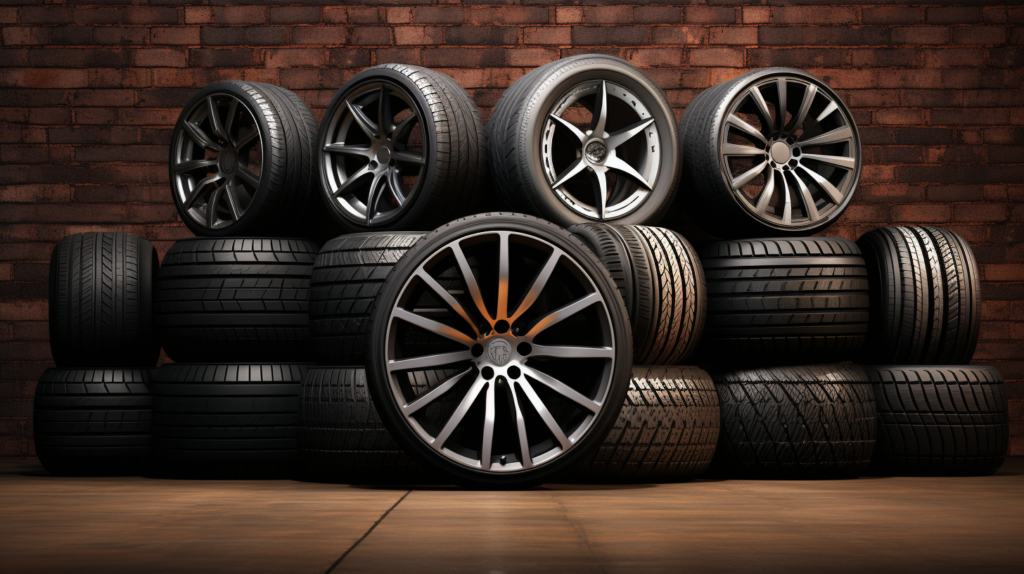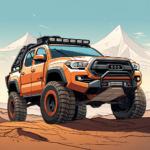Buying some aftermarket rims and tires is the fastest and most effective way to customize the look of your car or truck to really make it yours. Whether you want to be flashy and standout, go to the racetrack, or go off-roading, there is a set of rims and tires out there that are better fitted for you than what came with your car.
Most car manufacturers do not utilize wheels and tires for specialty uses. Usually, the OEM (original equipment manufacturer) wheels are meant for road driving only.
While many people don’t take the time or consideration to buy new wheels, if you want to make your vehicle special, buying new wheels and tires is a must. I’ve had aftermarket wheels on my first two vehicles, and I intend on buying a set for my new one as well. In both cases, my cars went from boring and mundane to standing out and drawing attention. I used to get a ton of comments and compliments about them all the time.
With that being said, buying a new set of rims and tires can be a bit overwhelming if you’ve never done it before. There are way more details that you need to pay attention to that I initially didn’t know about either.
I’m going to walk you through the necessary steps to take before purchasing your new wheels. I’m also going to give you a cheat code to make this process extremely easy and save you some money while doing it.
Before I get started, if you’d like to skip ahead without worrying too much about the technical details in regard to the wheel buying process, skip down to the final section to see my favorite method of buying wheels and tires.
Rim Specs
I’m going to start with rims because I think for most people, this is what matters the most. It is going to be what changes the aesthetic of your vehicle the most. I like to pick this first and ensure it fits my vehicle. After picking my rims is when I’ll start to worry about tire dimensions.
The rim or wheel choice you go with will have a bunch of different measurements that you need to pay attention to in order to ensure proper fitment.
Rim Diameter
Your vehicle will come standard from the factory with its original wheel diameter. While it isn’t necessary to keep the exact same diameter as stock, it’s important to keep it in the back of your mind. The rim diameter along with the tire sidewall measurement creates our total rolling diameter. If your upgraded rolling diameter is too different to the stock OEM one, your speedometer will read inaccurately. That means you can be speeding or going way too slow, but not realize it.
Whether you want bigger rims (more aesthetic) or bigger tire sidewall (better treat for off roading), there are adjustments that can be made to compensate for our changes. If you want bigger rims, let’s say you’re going from 18″ to 20″ wheels, your tire sidewall needs to be decreased in order to match the OEM rolling diameter. Likewise, if you want bigger tires with more tread, you need to decrease the size if your rims, let’s say from a 18″ to a 16″.
I’d definitely recommend using a wheel and tire retailer or consulting with a qualified mechanic before purchasing to ensure proper dimensions.
Rim Offset Diameter
Your rim offset is probably the most difficult aspect of this process to understand. Picture your rim having a line running perfectly down the middle. This is your “0” or your center point. The offset is the measurement of how far off the mounting face of the wheel is from the center point. The offset can be positive (+) or negative (-). The inside half of the wheel is your negative side, and the outside half of your wheel is your positive side. If you have a super negative offset, the wheels are going to poke out quite far. If you have a super positive offset, the wheels will be nicely tucked in under the car. Most stock wheels are going to have a fairly positive offset.
Rim Width
The width of the rim simply measures how wide the wheel is. This number is important for tire choice. If you vary too far from OEM width, you may risk rubbing at certain angles. We want to avoid this at all costs if possible. In my limited experience, I’ve always kept the same rim width as OEM recommended. However, my previous rims were purely for aesthetics, and not for performance. If you intend to race or off-road, your needs may differ. This is where I’d recommend seeking an experienced wheel installer of your specific vehicle.
Rim Material
The material your rim is made with, or rather the process in some circumstances, can determine how durable they may be. Some wheel-making processes allow for a weaker quality wheel for a cheaper price.
Steelies
Steelies are the steel wheels that usually come on base model cars with a hubcap over them. They are strong, but they are heavy and will negatively affect MPG’s and performance. These are generally the cheapest option for wheels.
Cast Wheels
Cast wheels are made by pouring molten aluminum into a mold and allowing it to cool and solidify. These wheels are still fairly cheap but are weaker than the rest of the options on the list. They are also usually simpler designs.
Roll-Formed Wheels
Roll-formed wheels start as a cast blank. Then the manufacturer puts a roller onto the blank and roll out the barrel. This makes for a pretty lightweight, performance-oriented wheel. Roll-formed wheels are going to be stronger than cast wheels but are more expensive.
Forged Wheels
Forged wheels are made by taking a billet of aluminum, putting it into a casting dye, and squeezing it really hard. This makes a really strong and lightweight wheel. Forged wheels are going to be stronger than cast and roll-formed wheels but will also be more expensive.
Multi-Piece Wheels
Multi-piece wheels will come as either a two-piece or three-piece wheel. The materials used for each piece can be made using all of the previously mentioned methods. Due to this, the strength of multi-piece wheels will vary by model. Multi-piece wheels have a separated barrel and face. Sometimes, the barrel will be made out of two pieces. These are typically the most expensive kinds of wheel you can buy.
Tire Specs
Buying tires can also seem pretty overwhelming due to how many different options there are. First and foremost, you need to determine what kind of driving conditions you will be facing. If you are off-roading, you need something with some better tread and beefier sidewall. If you live in a hot, dry climate without snow, summer tires are likely going to be fine. In the event that you experience snowfall throughout the year, you may want a set of both all-season tires and winter tires. Once you figure that part out, we can get into the technical bits.
Tire Size
The tire size is a batch of numbers that usually looks something like this: 235/60 R 14 82H. The 235 part is the width of the tire in millimeters. The 60 part is a percentage that measures how thick the sidewall is. It stands for 60% of the width of the tire, which in this case is 235mm. The sidewall size is always going to change depending on the width of a tire. For example, let’s take two different tires. One has a width of 235mm and the other has a width of 245mm. If they both have the same 60 series sidewall, the actual size of that sidewall is different because the tire width is different. Next, that 14 number simply stands for the size of the hole for the tire. In this example, the 14 means that this tire will fit a 14-inch rim.
Tire Rating
The 82H part of the tire code is your load rating. There is a whole table and algorithm that measures what the load rating of your tire is. Typically, the larger the vehicle, the higher the load rating needed to accommodate for the added weight of the vehicle. The tires will usually say what the load rating is in pounds without having to look up the load rating.
The H in the 82H is your speed rating. It will tell you the max speed that the tires are capable of before starting to delaminate and fall apart.
Treadwear
This rating is implemented to determine how fast the tread on your tire will wear down and when they will need to be replaced. Technically a 200 treadwear tire will last twice as long as a 100 treadwear tire. However, the manufacturers are the ones who make these ratings. There’s no universal standard to compare brand to brand. So, for example, a 200 treadwear Michelin tire will last two times as long as a 100 treadwear Michelin tire, but a 200 treadwear Michelin tire may only last 1.5 times as long as a 200 treadwear Bridgestone tire and vice versa.
Traction
This measurement is nationally standardized unlike the treadwear metric. It is designed to measure the straight line, wet traction of a tire to ensure grippiness of the rubber compound. There are four grades: C, B, A, AA. AA is going to be the most sticky rubber compounds.
Temperature
This is the measurement of how much heat a tire can take before falling apart. Once again, this is measured in a letter scale. A resists heat up to 115+ MPH. B resists heat from 100-115MPH. Lastly, C resists heat from 85-100MPH. Anything below a C ranking is illegal to sell in the USA.
Easiest Way to Buy Rims and Tires
If you are anything like I was when I was first learning about all these different specs and measurements, you’re probably thinking, “I’m overwhelmed this isn’t for me.” Don’t give up yet. I have the perfect solution for you.

My “cheat code” if you will, is a company called Tire Rack. Tire Rack is a company that sells rims and tires along with other vehicle parts like performance brake kits. They have an awesome program where you plug in the year, make, model, and trim of your vehicle and they will show you every wheel that they guarantee will safely fit it. I recommend using their “Wheel and Tire” package option because once you pick your wheel of choice, it will take you to the next page where you can buy tires that are guaranteed to fit the rims you just chose.
As if that wasn’t already an awesome feature, they also offer a 30-day money back guarantee if you have any issues with the new rims and tires as long as you entered your vehicle info into the program.
To sweeten the deal even more, they also offer fast free shipping on every order over $50 which is huge because rims and tires are heavy and can cost a pretty penny to ship.



